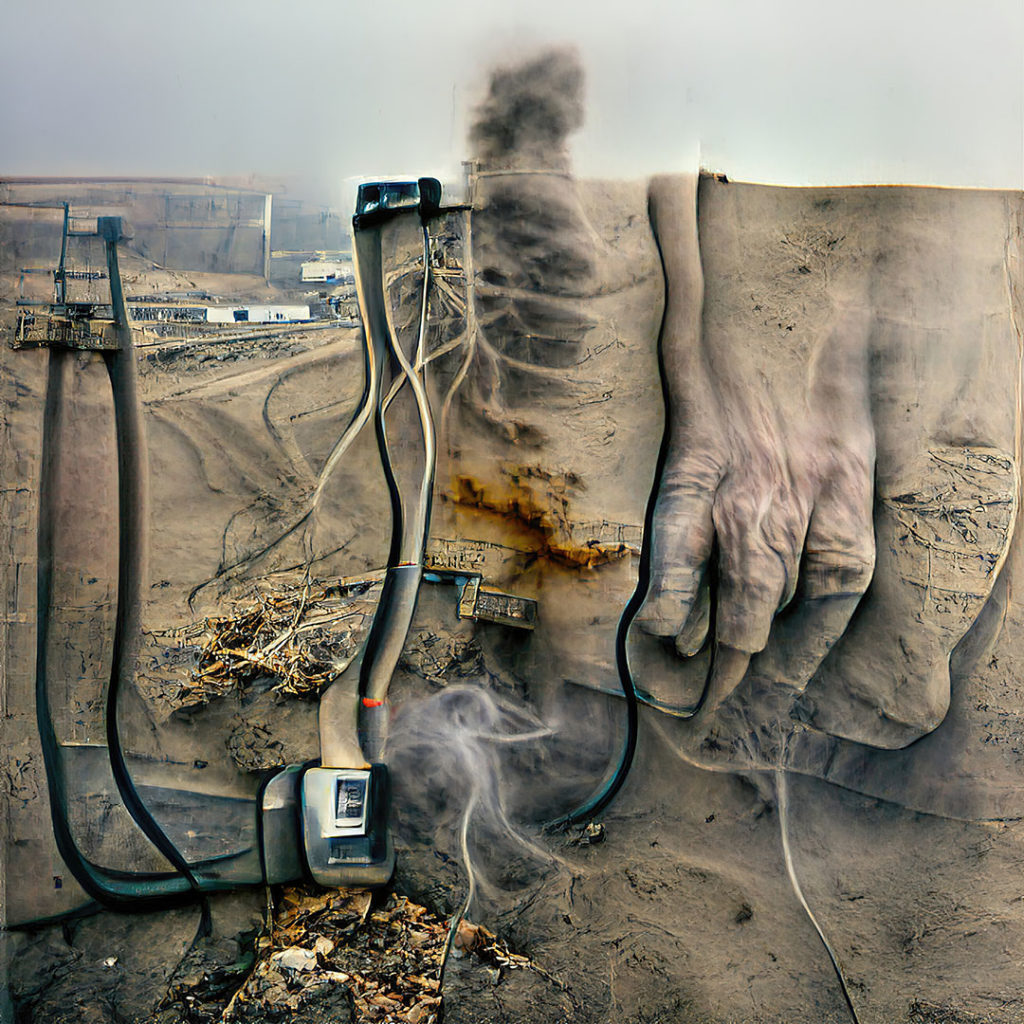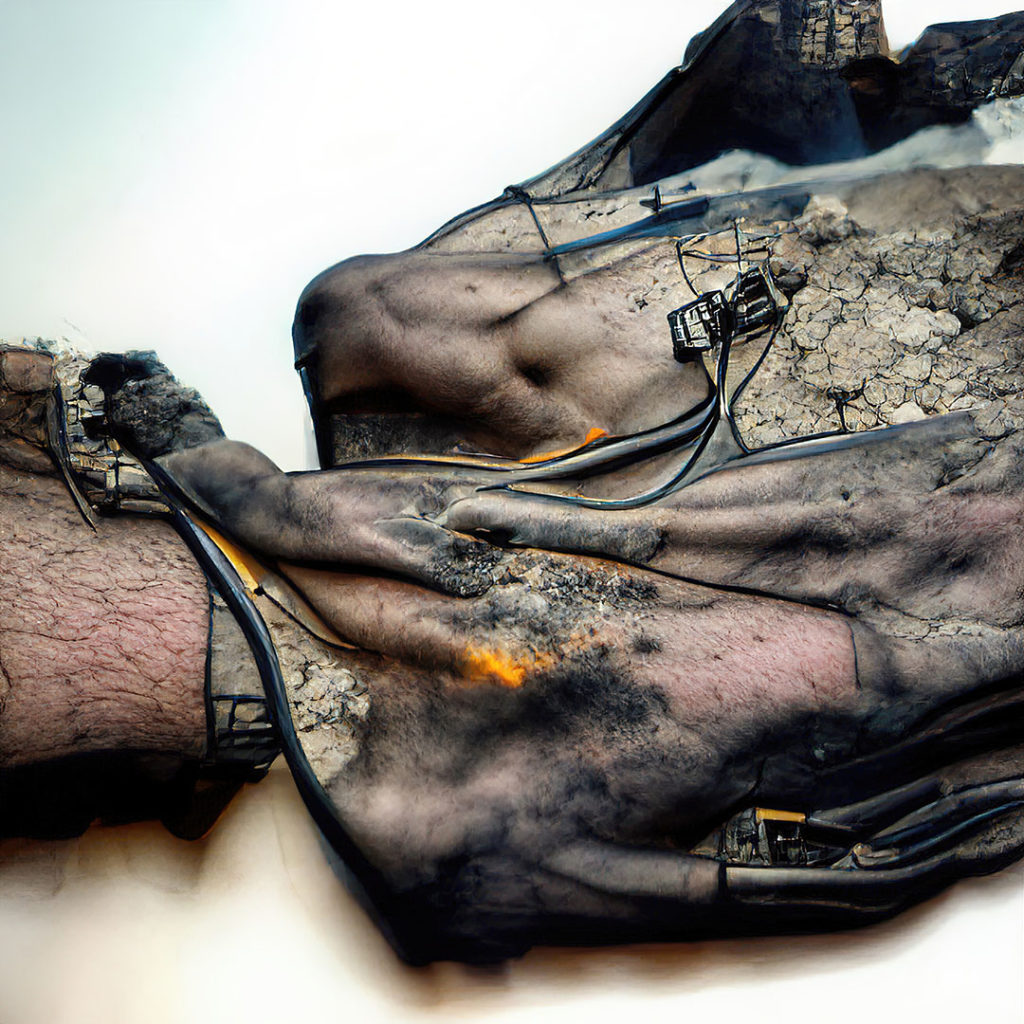L’art critique des NFT / The critical art of NFT

Les NFT voient la réactivation d’une stratégie bien connue dans l’art numérique qui trouve son origine dans la modernité.
Les NFT sont critiqués au titre de leur impact carbone, de leur colonialisme, de leur genre, de leur capitalisme, de leur économie, etc. Certains défendent alors la nécessité d’un art critique, c’est-à-dire élaborant une pensée s’opposant à ces différentes dominations, et le faisant du dedans par une prise en compte réflexive et un détournement-retournement du médium.
On reconnaît là la proposition greenbergienne de l’émancipation de l’art par la recherche de l’autonomie du médium. Celle-ci avait pour finalité de se détacher de la représentation réaliste bourgeoise, elle est maintenant un moyen de développer un discours (critique).
Le glitch est sans doute le paradigme de cette manière de faire et de penser : en s’immergeant dans les qualités techniques des codecs, on parviendrait à détourner la normalité inhérente à l’image numérique et à résister à l’hégémonie de la représentation.
Les résultats sont formellement intéressants, mais on peut s’interroger sur l’efficacité d’une telle stratégie du retournement du médium sur lui-même comme matière critique. En effet, celle-ci a la caractéristique d’être :
– un discours classique sur l’émancipation réflexive (la transparence à soi de la conscience, du médium),
– facilement reprise et intégrée esthétiquement par le marché (voir le glitch dans l’esthétique commerciale),
– une façon d’esthétiser le détournement et la résistance et d’en enlever le caractère insurrectionnel pour lui préférer la contemplation détachée,
– une recette artistique toute faite facile à appliquer à peu près à n’importe quoi.
D’un point de vue logique, la critique par la réflexivité du médium peut sembler légitime ou du moins tenir, mais d’un point de vue artistique et politique, elle relève d’une norme esthétique qui fait recette et qui produit, au bout du compte, des formes inoffensives et attendues (par exemple produire des NFT grâce aux API : le nouveau NFT est le produit de l’acquisition du précédent, et ainsi de suite) qui participent à la domination ou qui du moins ne la dérangent pas. En effet, celle-ci accepte tout à fait en son sein de belles perturbations. Il y a souvent dans cette stratégie un formalisme du résultat esthétique, allant de la mise en avant du pixel comme unité atomique aux vibrations impressionnistes du glitch.
Enfin, la réflexivité critique a ceci d’ambivalent qu’en réagissant à la domination, elle la met en scène et d’une certaine manière la valorise en en faisant son principal interlocuteur. En ce sens, elle pourrait être considérée comme une représentation de la puissance : la réflexivité devient une boucle, on critique alors le caractère tourbillonant et inconsistant de l’économie, on produit des NFT à partir de NFT, etc. Mais ainsi on se retrouve d’un point de vue sensible au chateau de Versailles, et on admire autant qu’on est effaré par la mise en scène surchargée et récursive de la puissance. La réflexivité est un miroir de miroir. N’est-il pas plus efficace, une fois que le discours critique est acquis, d’élaborer d’autres stratégies esthétiques, plus anarchiques, ne répondant plus à la domination comme à leur arché, et ouvrant d’autres mondes, c’est-à-dire une autre technique ?
–

The NFTs see the reactivation of a well-known strategy in digital art that originated in modernity.
The NFT are criticized for their carbon impact, their colonialism, their gender, their capitalism, their economy, etc. Some defend then the necessity of a critical art, that is to say elaborating a thought opposing to these various dominations, and doing it from the inside by a reflexive taking into account and a detour of the medium.
One recognizes there the greenbergian proposal of the emancipation of the art by the research of the autonomy of the medium. This one had for finality to detach itself from the bourgeois realist representation, it is now a means to develop a (critical) speech.
The glitch is undoubtedly the paradigm of this way of doing and thinking: by immersing oneself in the technical qualities of codecs, one would manage to divert the normality inherent in the digital image and to resist the hegemony of representation.
The results are formally interesting, but one can wonder about the effectiveness of such a strategy of turning the medium on itself as a critical matter. Indeed, this one has the characteristic to be :
- a classical discourse on reflexive emancipation (the transparency to oneself of the consciousness, of the medium),
- easily taken back and integrated aesthetically by the market (see the glitch in the commercial aesthetic),
- a way to aestheticize the detour and the resistance and to remove the insurrectionary character of it to prefer him the detached contemplation,
- a ready-made artistic recipe that can be applied to just about anything.
From a logical point of view, the criticism by the reflexivity of the medium can seem legitimate or at least hold, but from an artistic and political point of view, it is a matter of an aesthetic norm which makes recipe and which produces, at the end, harmless and expected forms (for example to produce NFT thanks to the API: the new NFT is the product of the acquisition of the previous one, and so on) which take part in the domination or which at least does not disturb it. Indeed, the latter accepts nice disruptions in its midst. There is often in this strategy a formalism of the aesthetic result, going from the putting forward of the pixel as an atomic unit to the impressionistic vibrations of the glitch.
Finally, the critical reflexivity has this of ambivalent that by reacting to the domination, it puts it in scene and in a certain way valorizes it by making its main interlocutor. In this sense, it could be considered as a representation of power: reflexivity becomes a loop, one criticizes then the whirling and inconsistent character of the economy, one produces NFT from NFT, etc. But in this way one finds oneself from a sensitive point of view at the Palace of Versailles, and one admires as much as one is appalled by the overloaded and recursive staging of power. Reflexivity is a mirror of mirrors. Is it not more efficient, once the critical discourse is acquired, to elaborate other aesthetic strategies, more anarchic, no longer responding to domination as their arche, and opening other worlds?
